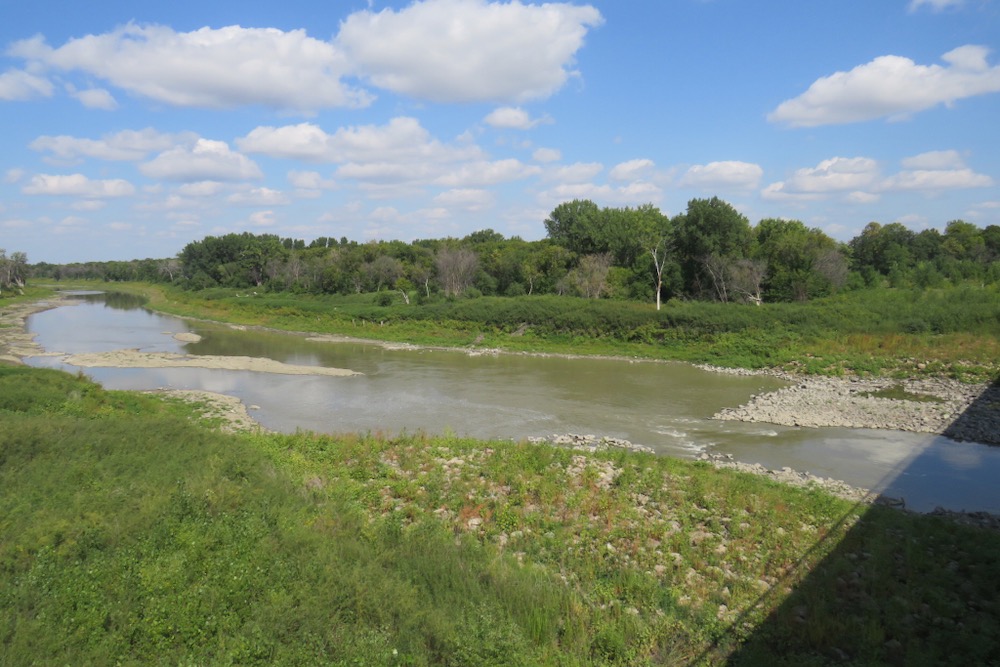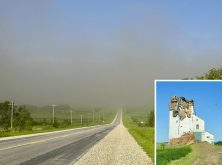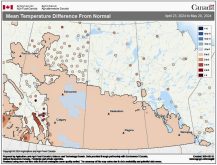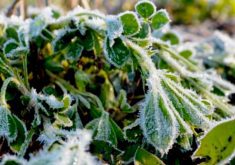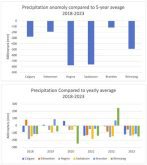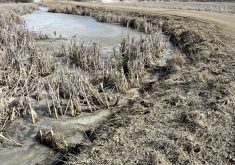WORRIES | Struggling dairy farmers not out of water yet, but are being careful, digging new wells, says Dairy Farmers of Manitoba
The water co-op that supplies some water to houses, hospitals, businesses and farms in Morden, Winkler, Altona, Carman and many other south-central communities has been forced to install temporary water intakes in the Red River after water levels fell too low to reliably reach its system.
“For us, our life is turned right upside down with all this because if you can’t get the water out of the river, even if there’s some there, it’s a problem,” said Greg Archibald, CEO of the Pembina Valley Water Cooperative (PVWC).
Read Also

Canadian canola prices hinge on rain forecast
Canola markets took a good hit during the week ending July 11, 2025, on the thought that the Canadian crop will yield well despite dry weather.
Steadily dropping
Two of the co-op’s three water treatment plants source water from the Red River. The other takes water from Stephenfield Lake.
The flow of the Red River, as measured at Emerson, dropped to 509 cubic feet per second from 1,530 cubic feet per second between June 25 and August 30, PVWC’s website says.
The water level fell just over 28 inches in that time, though recent rains raised it about an inch.
Lake Minnewasta, Morden’s main water source, is nearly 10 feet below full supply level, said Morden city manager Nicole Enns. Recent rains added about three inches.
“We could use a lot more rain,” Enns said.
On August 6, Winkler, Morden and the RM of Stanley declared a state of emergency and instated further water restrictions on top of those that were already in place.

“Not only for now, but to save for the future months if we don’t get a recharge in water supply over the winter,” the communities said in a joint news release.
The RM of Stanley posted water reduction measures at municipal bulk wells and asked residents to consider eliminating or significantly reducing their use of these wells.
Residents are not allowed to water lawns from any municipal water source, and municipal staff also stopped all landscape watering from municipal sources. Residents were encouraged to use rainwater, repurposed household water, or water from swimming pools.
Enns said Morden will install a 10,000-gallon, heated water tank at its arena to flood and maintain ice this winter and will source water outside of the community.
The water restrictions will continue as is into winter, Enns said.
Contingency plans
As Lake Minnewasta draws down, officials in Morden, Winkler and with PVWC are making plans to supply Morden if the lake fails. While the details are not finalized, it may involve decreasing Winkler’s share of water from PVWC and increasing Morden’s share.
Winkler takes about 65 per cent of its water from its aquifer and 35 per cent from PVWC, said Winkler city manager Jody Penner.
However, PVWC has had to put its own contingency plans into practice. It recently installed a temporary water intake at its Letellier treatment plant because water wasn’t reaching its permanent intake anymore.
It’s pursuing a similar plan at its Morris plant, where the permanent intake is about halfway out of the water, said Archibald.
The co-op studied the river to find deep spots to get them through winter, Archibald said.
Along with the residents of 14 municipalities, PVWC supplies Boundary Trails Health Centre and the Altona hospital, Archibald said. The municipalities host industrial sites like Bunge in Altona and cattle, chicken and hog operations.
Those are the urgent things, said Archibald. However, there are further plans to think of. The co-op is developing plans for if the river ran dry, including negotiating with another water co-op to potentially tie into its system.
It’s considering digging a pond at the Letellier treatment plant that could hold a year of water. Morris already has a pond with a six-month backup supply.
Provincial officials, including Infrastructure Minister Ron Schuler and local MLAs have been keeping tabs on the issue, said Archibald. PVWC has asked the province for further help.
“The province is working closely with Pembina Valley Water Cooperative to provide water conditions updates; engineering, technical and planning support; regulatory approvals and guidance; and in some cases, funding support, for example, through the Manitoba Water Services Board,” a provincial spokesperson said in an emailed statement.
Several provincial departments are involved, including Manitoba Agriculture and Resource Development (MARD) and Manitoba Infrastructure, the spokesperson said. Staff are meeting with PVWC at least twice per week.
“The Manitoba Water Services Board is currently managing several projects to upgrade the Pembina Valley Water Cooperative system including upgrades to the Stephenfield water treatment plant; pipeline and booster stations within Pembina Valley Water Cooperative’s system to improve supplies to the RM of Stanley, City of Morden and City of Winkler; and upgrades to the Letellier water treatment plant including a new intake and raw water pipeline upgrades,” the spokesperson said.
Not all of those projects are directly related to drought.
Dairy danger
Earlier this summer, Dairy Farmers of Manitoba reported some of its members were facing rapidly emptying wells. One farmer told DFM they had three or four weeks of water left.
Concerns came from across Manitoba, but were concentrated in the central region, including the Morden and Winkler area, said DFM chair David Wiens.
As of September 2, those farms were still hanging on.
“Their hand wasn’t forced back in August at some point. They’re still in,” Wiens told the Co-operator in a Sept. 2 interview.
Some of those farms had resorted to drilling new wells.
“How long those wells maintain water, that is a question,” Wiens said.
A provincial deadline extension for the Managing Livestock Access to Riparian Areas BMP, announced August 19, will provide some help, said Wiens.
The program, which will accept applications until October 1, offers funding toward constructing new wells and dugouts or rehabilitating old ones; constructing alternative watering systems, and other water-related projects.
There are some dairy farms supplied by PVWC, Wiens said. They’re being careful with water use, but can’t shortchange much.
“Cows need to drink a lot of water to produce milk,” he said. “The needs of the cow have to be looked after. That is kind of a non-negotiable.”
For more content related to drought management visit The Dry Times, where you can find a collection of stories from our family of publications as well as links to external resources to support your decisions through these difficult times.






